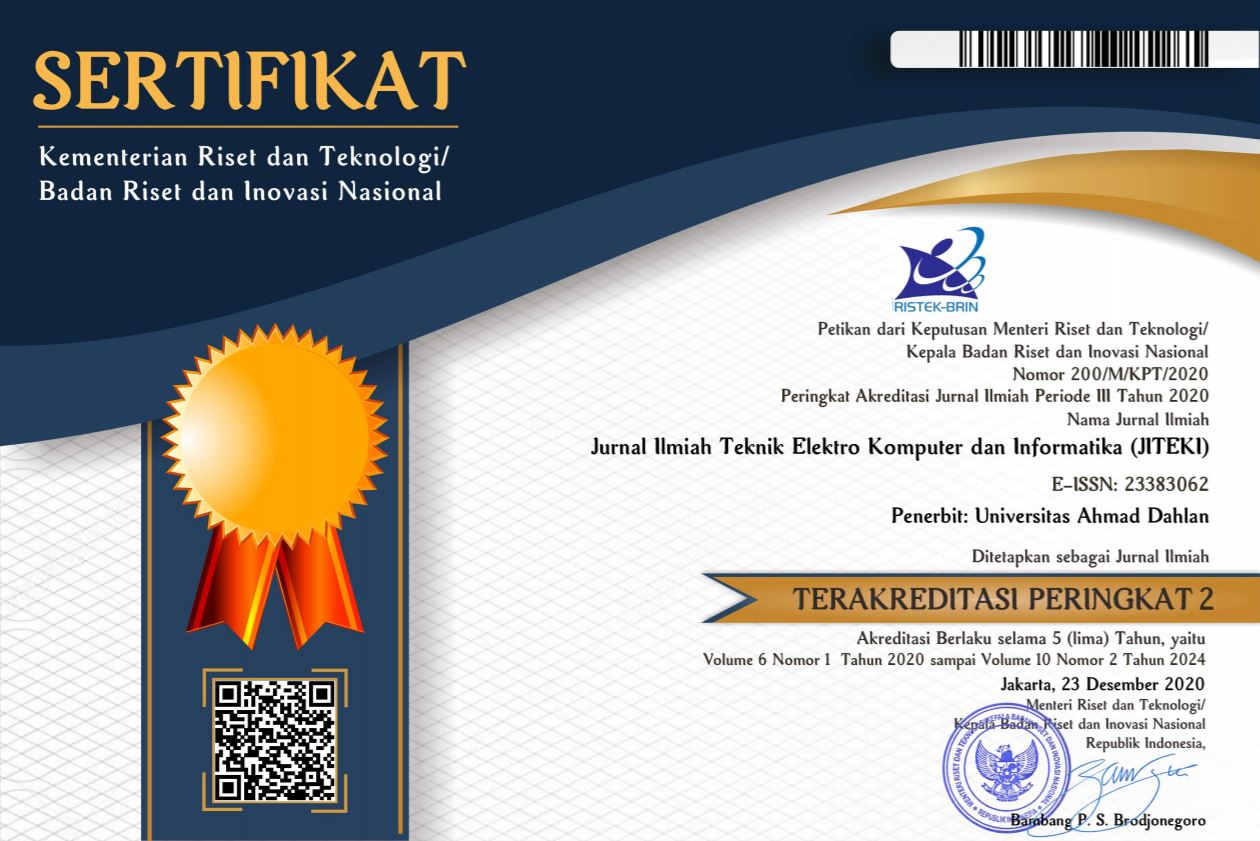Performance Evaluation of Wireless Charger Antenna Design of Mobile Phone
DOI:
https://doi.org/10.26555/jiteki.v3i1.5861Abstract
Using cable as power transmission medium cause problem in flexibility and aesthetics. Wireless power transmission for charging handphone released nowadays still using antenna with radiation pattern focus in one direction, that is just toward the top, and if the antenna was shifted then power transmitted will be lose. The purpose of this research is to produce wireless power charger system used for charging handphone power using resonator based on omnidirectional antenna and test the performance. The device in this research was designed in two main part, that is transmitter and receiver. In transmission section, there is power supply used for supplying power to oscillator to generate oscillating signal in the form of electrical power to be transmitted to receiver via antenna in the form magnetic field. In receiver section, receiver antenna received the power transmitted that is still in the reach of magnetic field generated by transmitter. The power that is still in the form of oscillating signal, then stabilized for the purpose of handphone power using rectifier and voltage regulator. Design has been made successfully to the form of handphone battery power wireless charger using omdirectional antenna which consist of two main part, that is transmitter and receiver. The transmitted power is 3.058 watt with frequency 714 KHz, and receiver received the power and then stabilized the signal to produce output power 58.706 miliwatt. This device can transmit power in all directions horizontally (angle 360°). This device also tested with some kind of obstacle, with the result almost all obstacle still could transmit the power except metal.
References
M. Fareq, M. Fitra, M. Irwanto, Syafruddin. HS, N. Gomesh, M. Rozailan, M. Arinal, Y.M.Irwan, J.Zarinatul. Wireless Power Transfer by Using Solar Energy. TELKOMNIKA. 2014; 12(3): 519-524.
Xiaoming Liu, Enjie Ding, Duan Zhao, Youfang Yang. Power Characteristics of Wireless Charging for Sensor Networks in Tunnels. TELKOMNIKA. 2015; 13(4): 1180-1186.
Qifan Li, Yung C. Liang. An Inductive Power Transfer System With A High-Q Resonant Tank For Mobile Device Charging. IEEE transactions on power electronics. 2015; 30(11): 6203-6212.
Sprott, J. C. (2006). Physics Demonstrations. Wisconsin: The University of Wisconsin Press.
MIT News. Goodbye wires! MIT team experimentally demonstrates wireless power transfer, potentially useful for powering laptops, cell phones without cords. from: http://newsoffice.mit.edu/2007/wireless-0607. 2007.
Octova, M. Analysis And Design of Receiver Circuit On Wireless Power Transfer System. Depok: Universitas Indonesia.2010.
Darmawan, I. UI Researchers Create Wireless Cell Phone Charger. from: http://teknologi.news.viva.co.id/news/read/208207-peneliti-ui-buat-pengecas-ponsel-nirkabel. 2011.
Atar, M. Design of Wireless Power Conductor. Depok: Universitas Indonesia, 2012.
S Chanda, A De. Congestion relief of contingent power network with evolutionary optimization algorithm. TELKOMNIKA (Telecommunication, Computing, Electronics and Control). 2012; 10 (1), 1-8
Tucker, C. A. Transmission of Wireless Power by Magnetic Resonance. Dissertation. UK :The University of Reading. 2013.
Downloads
Published
How to Cite
Issue
Section
License
Authors who publish with JITEKI agree to the following terms:
- Authors retain copyright and grant the journal the right of first publication with the work simultaneously licensed under a Creative Commons Attribution License (CC BY-SA 4.0) that allows others to share the work with an acknowledgment of the work's authorship and initial publication in this journal.
- Authors are able to enter into separate, additional contractual arrangements for the non-exclusive distribution of the journal's published version of the work (e.g., post it to an institutional repository or publish it in a book), with an acknowledgment of its initial publication in this journal.
- Authors are permitted and encouraged to post their work online (e.g., in institutional repositories or on their website) prior to and during the submission process, as it can lead to productive exchanges, as well as earlier and greater citation of published work.

This work is licensed under a Creative Commons Attribution 4.0 International License

